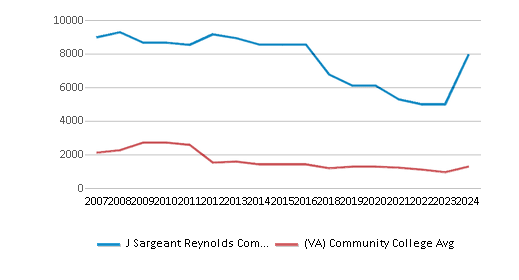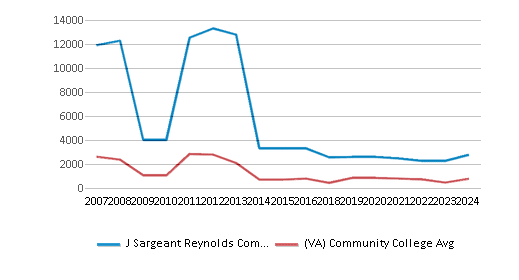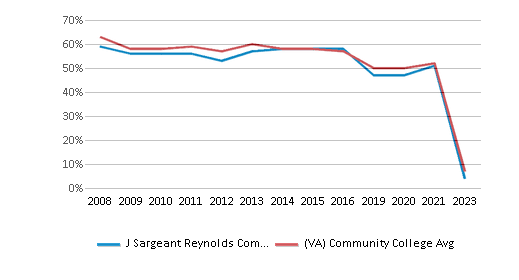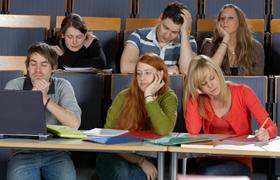- J. Sargeant Reynolds Community College provides access to education that develops individuals for employment and career advancement, prepares students for successful transfer to colleges and universities, promotes personal enrichment and lifelong learning, and builds a skilled workforce that contributes to regional economic development.
School Highlights
J Sargeant Reynolds Community College serves 10,717 students (26% of students are full-time).
The college's student:teacher ratio of 20:1 is lower than the state community college average of 23:1.
Minority enrollment is 54% of the student body (majority Black), which is more than the state average of 53%.
Quick Stats (2025)
- Enrollment: 10,717 students
- In-state tuition: $4,428
- Out-state tuition: $10,266
- Student:teacher ratio: 20:1
- Minority enrollment: 54%
- Source: Integrated Postsecondary Education Data System (IPEDS)
Top Rankings
J Sargeant Reynolds Community College ranks among the top 20% of public schools in Virginia for:
Category
Attribute
Community Size
School Overview
The teacher population of 532 teachers has stayed relatively flat over five years.
J Sargeant Reynolds Community College
(VA) Community College Avg.
Carnegie Classification
Associate's Colleges: High Career & Technical-High Nontraditional
Associate's--Private For-profit
Institution Level
At least 2 but less than 4 years
At least 2 but less than 4 years
Institution Control
Public
Private, non-profit
Total Faculty
532 staff
129 staff

School Calendar
Student Body
The student population of J Sargeant Reynolds Community College has grown by 23% over five years.
The student:teacher ratio of 20:1 has increased from 15:1 over five years.
The J Sargeant Reynolds Community College diversity score of 0.69 is less than the state average of 0.71. The school's diversity has stayed relatively flat over five years.
Total Enrollment
10,717 students
1,350 students

Student : Teacher Ratio
20:1
23:1

# Full-Time Students
2,766 students
637 students

# Part-Time Students
7,951 students
971 students



# Enrollment Undergraduate
107 students
314 students
# Full-Time Undergraduate Students
2,766 students
611 students

# Full-Time Graduate Students
n/a
158 students
# Part-Time Undergraduate Students
7,951 students
971 students
# Part-Time Graduate Students
n/a
61 students
Total Dormitory Capacity
n/a
476 students
% American Indian/Alaskan
n/a
n/a

% Asian
7%
8%

% Hispanic
8%
13%

% Black
29%
21%

% White
46%
47%

% Hawaiian
n/a
n/a

% Two or more races
5%
5%

% Non Resident races
2%
2%

% Unknown races
3%
4%


Diversity Score
0.69
0.71

College Completion Rate (Students who graduate in less than 4 years)
0.2647%
0.4094%

College Completion Rate (Students who graduate in 4 years or more than 4 years)
n/a
0.264%
Average Graduate Earnings (10 Years)
$32,600
$29,600

Tuition and Acceptance Rate
The public in-state tuition of $4,428 is more than the state average of $3,748. The in-state tuition has declined by 11% over four years.
The public out-state tuition of $10,266 is more than the state average of $8,977. The out-state tuition has declined by 6% over four years.
In-State Tuition Fees
$4,428
$3,748

Out-State Tuition Fees
$10,266
$8,977

% Students Receiving Some Financial Aid
60%
78%

Median Debt for Graduates
$12,000
$10,500

Median Debt for Dropouts
$7,198
$5,500

Acceptance Rate
n/a
59%
Source: 2024 (or latest year available) Integrated Postsecondary Education Data System (IPEDS)
School Notes
- J. Sargeant Reynolds Community College - Virginia's newest community college - was founded in 1972 to serve the capitol region in and around the city of Richmond. In just over 25 years, J. Sargeant Reynolds has grown into the third largest college in the Virginia Community College System, enrolling students at three major campuses, at 5 off-campus sites, and "virtually" through distance learning. J. Sargeant Reynolds Community College has three academic campuses - the Downtown Academic Campus, the Parham Road Academic Campus and the Western Academic Campus. The Parham Road Academic Campus, located one mile west of I-95 in Henrico County, offers college transfer programs in liberal arts, education, engineering, science, and computer science, as well as a broad range of occupational/technical programs in the areas of business, engineering, and public service. Students attend Reynolds for degrees that transfer to four-year universities and colleges in Virginia and elsewhere, degrees, certificates, and career studies certificates that prepare credit students for employment, credit courses for students who do not currently wish to complete an entire program - during the day, evening, on weekends, via distance learning and through dual enrollment and workforce development courses and services through the Community College Workforce Alliance (CCWA). JSRCC's occupational/technical plans, designed to prepare students for employment as technicians, paraprofessionals and skilled craftsmen. In these two-year plans, you can earn an Associate of Applied Arts (AAA) or Associate of Applied Science (AAS) degree. For even quicker and more focused preparation for an occupation, you can complete a Certificate (C) plan in two or three semesters.
Frequently Asked Questions
How much does J Sargeant Reynolds Community College cost?
J Sargeant Reynolds Community College's tuition is approximately $4,428 for In-State students and $10,266 for Out-State students.
What is J Sargeant Reynolds Community College's ranking?
J Sargeant Reynolds Community College ranks among the top 20% of community college in Virginia for: Largest student body.
Recent Articles

Obtaining Your Bachelor's Degree at a Community College
Explore the evolving landscape of community colleges offering bachelor's degrees, addressing affordability, accessibility, and workforce needs.

A to Z of Community College Certificates and Courses
From business and healthcare to technology and skilled trades, the article showcases the breadth of options available to students seeking to enhance their knowledge, develop new skills, or pursue career advancement.

What is a Community College?
This comprehensive guide explains what a community college is, its history, and its role in higher education. It covers the types of programs offered, differences from four-year colleges, benefits of attending, and important considerations for prospective students, providing valuable insights for those exploring educational options.






